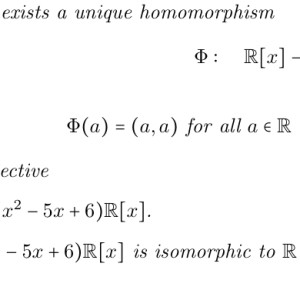Homomorphism
Answer
Answers can only be viewed under the following conditions:
- The questioner was satisfied with and accepted the answer, or
- The answer was evaluated as being 100% correct by the judge.
 Martin
Martin
1.7K
The answer is accepted.
Join Matchmaticians Affiliate Marketing
Program to earn up to a 50% commission on every question that your affiliated users ask or answer.
- answered
- 1402 views
- $20.00
Related Questions
- Homomorphism
- Generating set for finitely generated submodule of finitely generated module
- Mean Value Theorem
- [Modules] Show that $h_3$ is injective given comutative diagram
- Let $R$ be an integral domain and $M$ a finitely generated $R$-module. Show that $rank(M/Tor(M))$=$rank(M)$
- Rotational symmertries of octahedron, $R(O_3)$
- Certain isometry overfinite ring is product of isometries over each local factor
- Question on a subgroup of permutations

